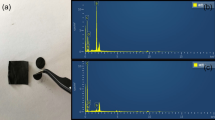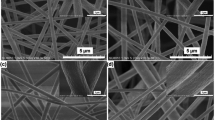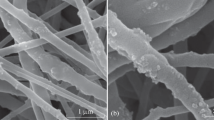Abstract
The current study explored the application of the electrospinning technique to produce multi-hierarchical composites for hydrogen storage applications. Predetermined control of fibre porosity is expected to enable production of well-defined hierarchical pore structure. The study involved encapsulation of highly porous zeolite-templated carbon (ZTC) into electrospun fibres and testing of the resulting composites for hydrogen storage. The hydrogen storage capacity of the composite fibres was 1.83%, compared with 2.39 wt% for powder ZTC material. The potential of the electrospinning technique as a shaping option for preparing composites from loose powder is demonstrated. The ZTC–polyacrylonitrile (ZTC-PAN) composite retained about 76% of the hydrogen storage capacity of the ZTC. Vacuum degassing of the ZTC–PAN electrospun composite was also found to enhance the development of porosity, aiding hydrogen penetration into zeolite pores.
Similar content being viewed by others
Explore related subjects
Discover the latest articles, news and stories from top researchers in related subjects.Avoid common mistakes on your manuscript.
Introduction
Rapid depletion of fossil-fuel reserves coupled with environmental damage caused by their combustion necessitate the development of alternative, clean energy sources. One leading candidate in this endeavour is hydrogen, which can be used as an energy carrier because of its high energy density, zero emissions and production from non-depletable resources, such as water [1, 2]. The major challenge hindering development of hydrogen into a global energy carrier is the lack of safe and effective storage technologies for both stationary and mobile applications [2]. Although many technologies and materials for hydrogen storage are available, none satisfy the US Department of Energy (US-DOE) requirements [3]. A prospective solution to this problem is use of porous materials such as metal-organic frameworks and porous carbons for hydrogen storage [2, 4]. Zeolite-templated carbons (ZTCs) have been identified as offering a promising solution, since they possess attractive properties that are suited for hydrogen storage [5], including high surface area, tunable porosity and that they can be synthesised relatively inexpensively [6]. Previous studies on ZTC reported remarkable hydrogen uptake capacity (7.3 wt% at 20 bar and 77 K), among the highest values recorded for carbon materials [5]. However, use of unprocessed loose powders in hydrogen storage systems is known to cause engineering disadvantages during system integration, since it leads to contamination of pipelines [7]. To address this challenge, various shaping techniques have been proposed and recommended [8]. Among the many different ways of processing porous materials [2, 8], the electrospinning technique has been proposed as a promising technology, since it enables production of materials with hierarchical pore structure [9]. The electrospinning process is attractive mainly because it can be easily scaled up and the resulting fibres can also be modified to achieve attractive hydrogen sorption properties [10, 11]. A recent paper [12] highlighted the application of an electrospraying technique, mentioning incorporation of colloidal suspensions of superporous zeolite-templated carbon (ZTC) to produce continuous carbon coatings for electrochemical energy storage applications. Therefore, the current study adopts the electrospinning technique to incorporate ZTC into a polymeric solution, resulting in ZTC–PAN composite fibres having hydrogen storage capacity close to that of pristine ZTC powder.
Materials and methods
Reagents and chemicals
The procedure for synthesis of zeolite-templated carbon was reported previously [6]. Commercially available zeolite 13X (Sigma-Aldrich) was used as template. Polyacrylonitrile (PAN, M w = 150,000, Sigma-Aldrich) and N,N-dimethylformamide (DMF, Sigma-Aldrich, 99.8%) were purchased and used without further purification. Our choice of polymer and solvent stemmed from literature, since PAN is the most well-documented polymer used for electrospinning. PAN is also easily dissolved in DMF, which has good conductivity of 10.90 µS cm−1 and dipole moment of 3.82 Debye, thus being excellent for electrospinning [7].
Electrospinning processing
Various amounts of ZTC (7.5, 10, and 12.5 wt%) were incorporated into 10% PAN polymeric solution prepared with DMF as solvent. The quantity of ZTC incorporated was determined as a relative ratio to the weight of polymeric solution. The resulting ZTC–PAN mixture was initially stirred with a magnetic rod for 60 min, then sonicated for an additional 10 min. Thereafter, the resulting ZTC–PAN solution was transferred into a syringe with a metallic needle. A conventional electrospinning setup including a KDS scientific syringe pump (model 100), Glassman high-voltage power supply and aluminium foil sample collector was assembled [9]. The flow rate of the polymeric blend was set at 2.8–3.0 mL h−1, the distance between the needle tip and the aluminium foil collector plate was fixed at 10 cm, and voltage of 8–10 kV was applied. Ambient temperature and humidity ranged from 19 to 25 °C and 40 to 60%, respectively. Upon completion of the electrospinning process, the composite fibres were transferred to a sample tube and heat-treated at 280 °C under vacuum for 180 min in the Micromeritics ASAP 2020 HD analyser degassing port (referred to as vacuum degassing).
Characterisation
An Auriga Cobra focussed-ion beam scanning electron microscope (FIB-SEM) was used to study the surface morphology and ZTC particle distribution in the resulting electrospun composites. A thermo-gravimetric analysis (TGA) instrument (Mettler Toledo, TGA/SDTA 851e) was used to study the thermal stability of the obtained samples. In this case, about 10 mg composite fibre was loaded into a pan and heated to 1000 °C at rate of 10 °C min−1 with air flow of 10 mL min−1. Surface area and pore characteristic measurements were carried out on an ASAP 2020 HD analyser (Micromeritics) using N2, and Brunauer–Emmett–Teller (BET) surface areas were obtained from the linear region of N2 isotherms. Volumetric H2 adsorption isotherms at 77 K and up to 1 bar were also measured on the ASAP 2020 instrument. All gas sorption isotherms were obtained using ultra-high-purity grade (99.999%) gas.
Results and discussion
The SEM image in Fig. 1a shows the octahedral pyramidal shape of the zeolite-templated carbon, which is a morphological replica of its parent zeolite X [5, 6]. It is also evident that the pristine electrospun fibres (Fig. 1b) were smooth and no beading occurred during the electrospinning process. A good distribution of ZTC onto the PAN fibres can be observed in Fig. 1c–e, and the higher-magnification image inset in Fig. 1e shows that a highly porous zeolite–PAN fibre composite was obtained after vacuum degassing. Unlike other studies, where non-porous PAN fibres were often obtained [13], the degassing step adopted in this study enabled creation of mesopores as the DMF solvent escaped from the ZTC micropores as well as from the fibre itself. The distribution of ZTC onto the fibre composite was also observed to depend on the amount of ZTC incorporated into the PAN polymeric solution. The highest amount of ZTC obtained was 12.5 wt%, since higher values led to very viscous polymeric mixture that was difficult to electrospin.
The thermo-gravimetric analysis results in Fig. 2 show that the PAN fibres were stable up to about 400 °C, after which large mass loss was observed. Compared with pristine PAN fibres, the 12.5% ZTC–PAN composite fibres were found to be relatively more thermally stable, since the onset of rapid degradation started at about 500 °C. Even though the composite fibres were less stable than the powdery ZTC, the improvement in the stability of the composite ZTC/PAN fibre is of interest, since it would allow further heat-related post-synthesis modifications that could be employed to improve their hydrogen storage capacity. In all the analysed materials, complete structural destruction occurred at about 700 °C, which can be ascribed to the carbonisation process leading to their complete combustion.
The N2-sorption isotherms shown in Fig. 3a confirm a type IV class of isotherm, except for the pristine PAN fibres. The presence of a hysteresis loop indicates the presence of mesopores, which correlates well with the porosity observed in the SEM images in Fig. 1, especially for the ZTC–PAN composite fibres. The BET surface area of the powdery ZTC was found to be 2717 m2 g−1, whereas that of pristine PAN fibres was 13 m2 g−1. This was expected, since the high microporosity of ZTC will contribute to increased surface area, unlike the case of the non-porous PAN fibres. The trend in the isotherms observed while changing the amount of ZTC in the composite fibres (7.5, 10 and 12.5 wt%) can be explained based on the influence of the increased microporosity due to inclusion of ZTC. The surface area of 1787 m2 g−1 obtained for the 12.5% ZTC–PAN composite fibres is about 66% of that of powdery ZTC. The pore size distributions shown in Fig. 3b corroborate the SEM observations. Note that the powdery ZTC had narrow pore size distribution, averaging 10 Å, in agreement with previous reports [5]. The porosity showed an increasing trend with increasing amount of ZTC, while broadening of the pore size distribution was observed with higher amounts of ZTC due to creation of pores in the PAN towards the mesopore range, as also observed in the SEM images in Fig. 1.
Since surface area measurements can be correlated to hydrogen measurements [5, 6], comparison of the H2 isotherms in Fig. 4 indicates that the hydrogen storage capacity of the 12.5 wt% ZTC–PAN composite fibres (1.83 wt%) was about 76% that of powdery ZTC (2.39 wt%). There was negligible hydrogen uptake by the pristine PAN fibres, and the trend for the hydrogen adsorption of the ZTC–PAN composite fibres correlated with the variation in the amount of ZTC in the composite fibres. Subjecting the electrospun ZTC–PAN composite fibres to vacuum degassing conditions caused residual DMF to be extracted from the fibres, resulting in porosity, as evident from the SEM micrographs. Although vacuum degassing did assist in creating visible pores in the composite fibres (Fig. 1e), there is the possibility that some ZTC pores could still be blocked by the PAN.
Conclusions
Zeolite-templated carbon (ZTC) was successfully encapsulated into a PAN polymeric matrix to form composite fibres with hydrogen storage capacity of 1.83 wt%, being about 76% that of the powder ZTC. The potential of the electrospinning technique as a shaping option for loose powder is demonstrated. Vacuum degassing of the fibre composites was also found to enhance the development of porosity, aiding hydrogen penetration into the pores of ZTC. It is anticipated that the hydrogen storage capacity could be further increased if the pressure were increased from 1 to 20 bar as well as by the use of a polymer that can store hydrogen itself, such as polyaniline [14], which will be explored in future work. Since hydrogen storage at low temperatures (~77 K) is still considered a challenge, future work will also investigate the possibility of nano-confinement of metal hydrides within ZTC–PAN composite fibres to store hydrogen at room temperature.
References
J.S. Yang, H. Jung, T. Kim, C.R. Park, Recent advances in hydrogen storage technologies based on nanoporous carbon materials. Prog. Nat. Sci. Mater. Int. 22, 631–638 (2012)
H. Nishihara, T. Kyotani, Templated nanocarbons for energy storage. Adv. Mater. 24, 4473–4498 (2012)
K.M. Thomas, Hydrogen adsorption and storage on porous materials. Catal. Today 120, 389–398 (2007)
J. Ren, N.M. Musyoka, H.W. Langmi, B.C. North, M. Mathe, X. Kang, S. Liao, Hydrogen storage in Zr-fumarate MOF. Int. J. Hydrog. Energy 40, 10542–10546 (2015)
E. Masika, R. Mokaya, Preparation of ultrahigh surface area porous carbons templated using zeolite 13X for enhanced hydrogen storage. Prog. Nat. Sci. Mater. Int. 23, 308–316 (2013)
N.M. Musyoka, J. Ren, H.W. Langmi, B.C. North, M. Mathe, A comparison of hydrogen storage capacity of commercial and fly ash-derived zeolite X together with their respective templated carbon derivatives. Int. J. Hydrogen Energy 37, 12705–12712 (2015)
J. Ren, N.M. Musyoka, P. Annamalai, H.W. Langmi, B.C. North, M. Mathe, Electrospun nanofibers as hydrogen storage media. Int. J. Hydrogen Energy 40, 9382–9387 (2015)
J. Ren, H.W. Langmi, B.C. North, M. Mathe, Review on processing of metal–organic framework (MOF) materials towards system integration for hydrogen storage. Int. J. Energy Res. 39, 607–620 (2015)
S. Cavaliere, S. Subianto, I. Savych, D.J. Jones, J. Rozière, Electrospinning: designed architectures for energy conversion and storage devices. Energy Environ. Sci. 4, 4761–4785 (2011)
Z.M. Huang, Y.Z. Zhang, M. Kotaki, S. Ramakrishna, A review on polymer nanofibers by electrospinning and their applications in nanocomposites. Compos. Sci. Technol. 63, 2223–2253 (2003)
D. Srinivasan, R. Rao, A. Zribi, Synthesis of novel micro- and mesoporous zeolite nanostructures using electrospinning. J. Electron. Mater. 35, 504–509 (2006)
J.M. Rosas, R. Ruiz-Rosas, R. Berenguer, D. Cazorla-Amorós, E. Morallón, H. Nishihara, T. Kyotani, J. Rodríguez-Mirasol, T. Cordero, Easy fabrication of superporous zeolite templated carbon electrodes by electrospraying on rigid and flexible substrates. J. Mater. Chem. A 4, 4610–4618 (2016)
S. Lee, J. Kim, B. Ku, J. Kim, H. Joh, Structural evolution of polyacrylonitrile fibers in stabilization and carbonization. Adv. Chem. Eng. Sci. 2, 275–282 (2012)
S.S. Srinivasan, R. Ratnadurai, M.U. Niemann, A.R. Phani, D.Y. Goswami, E.K. Stefanakos, Reversible hydrogen storage in electrospun polyaniline fibers. Int. J. Hydrogen Energy 35, 225–230 (2010)
Acknowledgements
The authors of this paper would like to acknowledge and thank the South African Department of Science and Technology (DST) for financial support towards the HySA Infrastructure (grant no. HTC004X). N.M.M. also acknowledges the CSIR-Young Researcher Establishment Funds (grant no. HTC005P).
Author information
Authors and Affiliations
Corresponding author
Rights and permissions
About this article
Cite this article
Annamalai, P., Musyoka, N.M., Ren, J. et al. Electrospun zeolite-templated carbon composite fibres for hydrogen storage applications. Res Chem Intermed 43, 4095–4102 (2017). https://doi.org/10.1007/s11164-017-2867-x
Received:
Accepted:
Published:
Issue Date:
DOI: https://doi.org/10.1007/s11164-017-2867-x








